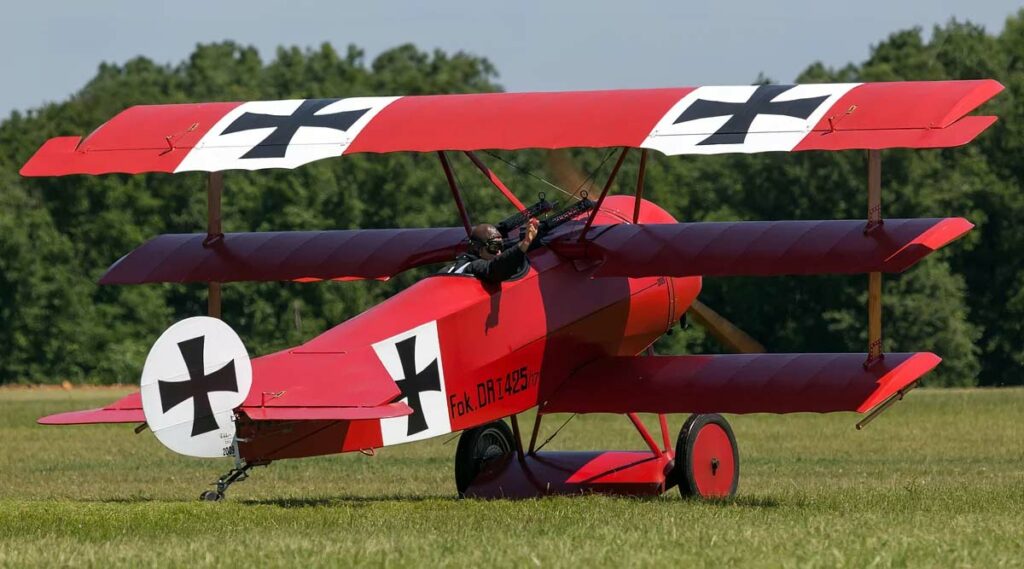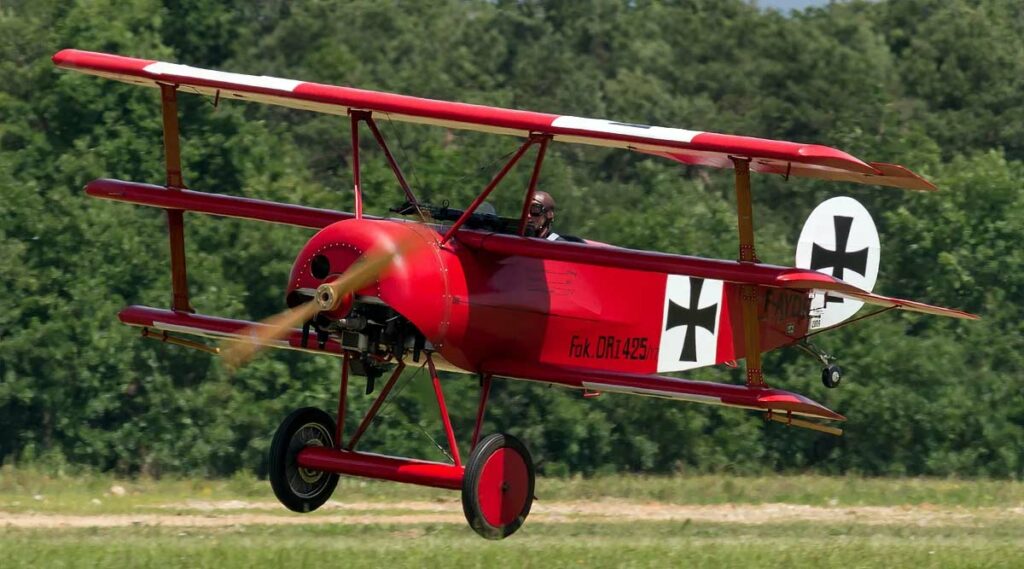WWI-era Fokker Dr.I: German triplane, rotary engine, synonymous with Manfred von Richthofen, legendary for agility and dogfighting prowess. The article discusses the Fokker Dr.I, a World War I German fighter aircraft. It details the development context, design intricacies, performance specifications, and military usage, offering a comprehensive look at this iconic triplane, best known for its association with the Red Baron.
The Fokker Dr.I triplane remains one of the most iconic aircraft of the First World War, immortalized by its association with the legendary German ace, Manfred von Richthofen, known as the Red Baron. Its distinctive three-wing design and impressive maneuverability made it a formidable opponent in the skies of WWI.

History of the Development of the Fokker Dr.I
The Fokker Dr.I was born out of the necessity for superior aerial combat capability during World War I. The epoch marked the dawn of aerial warfare, where the sky became a battlefield, and the demand for advanced fighter aircraft soared. During this time, the belligerents were in a constant race to develop aircraft that could secure air superiority.
The program for the Fokker Dr.I was launched by the Fokker-Flugzeugwerke company in Germany, led by the aeronautical engineer Anthony Fokker. The aim was to create an aircraft that could match or exceed the performance of the Sopwith Triplane, which had demonstrated exceptional maneuverability and climb rate in combat against the Germans.
The development was also a response to the call for aircraft that could engage in close-quarters combat with a high chance of survival and success. The Dr.I was specifically designed for dogfighting, with a focus on agility rather than speed, a design philosophy that set it apart from its contemporaries.
The first prototype flew in July 1917, with further modifications following test flights. Despite initial problems, including structural failures, the aircraft was rapidly put into production due to wartime urgency.
Design of the Fokker Dr.I
The Fokker Dr.I triplane was a radical departure from the biplane design that dominated the era. It featured three wings with a wingspan of 23 feet 7 inches (7.2 meters). The structure was a fabric-covered steel tube frame, which made it lighter and allowed for the agility it was known for. The design also included a fixed tail skid landing gear and a rotary engine that was typical of the period.
The compact design allowed for a significant reduction in wingspan to just over 7 meters (23 feet), a critical factor in the plane’s remarkable maneuverability. It was powered by a 110 hp Oberursel Ur.II, a German copy of the French Le Rhône engine. This rotary engine was key to the Dr.I’s performance, providing a power-to-weight ratio that was favorable for its time.
One of the main advantages of the Dr.I was its climbing ability and turning capacity. However, its rotary engine also had drawbacks, such as torque effects that could make the aircraft difficult to handle, especially for inexperienced pilots. It also had a relatively low top speed compared to its contemporaries, but this was a trade-off for its superior dogfighting capabilities.
The aircraft’s most distinctive feature was undoubtedly its triplane configuration. The three-wing design improved upward visibility for the pilot and contributed to the plane’s high degree of lift relative to its size.
Performance of the Fokker Dr.I
The Fokker Dr.I was powered by the Oberursel Ur.II 9-cylinder air-cooled rotary engine, which produced 110 horsepower. This engine allowed the aircraft to reach a maximum speed of approximately 115 mph (185 km/h), with an operational ceiling of 20,000 feet (6,096 meters). It had a range of around 185 miles (300 kilometers), which was sufficient for the short-range dogfights it was designed for.
In terms of power and speed, the Dr.I did not outclass all competitors. For example, the SPAD S.XIII, a French biplane, was capable of speeds up to 135 mph (217 km/h), significantly faster than the Dr.I. However, where the Dr.I excelled was in its rate of climb and turning abilities, which were crucial in dogfight scenarios of WWI.

Military Use and Combat of the Fokker Dr.I
The armament of the Fokker Dr.I typically consisted of two 7.92 mm Spandau LMG 08/15 machine guns, which were synchronized to fire through the propeller arc. This armament was standard for German fighters at the time and proved effective in the close-quarter dogfights that the Dr.I engaged in.
The aircraft saw extensive combat in the hands of German pilots, most notably Manfred von Richthofen, who secured many of his last victories in the Dr.I before his death in April 1918. The Dr.I’s operational history was marked by both impressive achievements and notable challenges. Structural failures in the wings led to a temporary grounding of the planes until reinforcements were made.
The Dr.I faced several competing aircraft, including the aforementioned SPAD S.XIII, the British Sopwith Camel, and the SE.5a. While faster and sometimes more heavily armed, these aircraft did not match the Dr.I in maneuverability.
The Fokker Dr.I was not sold to other countries during its operational life, as it was a product of a nation at war with limited production capacity. Its service was relatively short-lived; by the end of WWI, it was being replaced by more advanced designs like the Fokker D.VII. The triplane was completely phased out of service shortly after the war, with the last recorded flights in the early 1920s.
The Fokker Dr.I triplane remains a remarkable symbol of WWI aviation. Its design, while not without flaws, represented an innovative approach to meeting the tactical demands of the time. Though its service was brief, the legacy of the Fokker Dr.I, especially its association with the Red Baron, endures as a testament to the rapid development of aircraft during the Great War and the brave pilots who flew them.
Back to the Warbirds section.